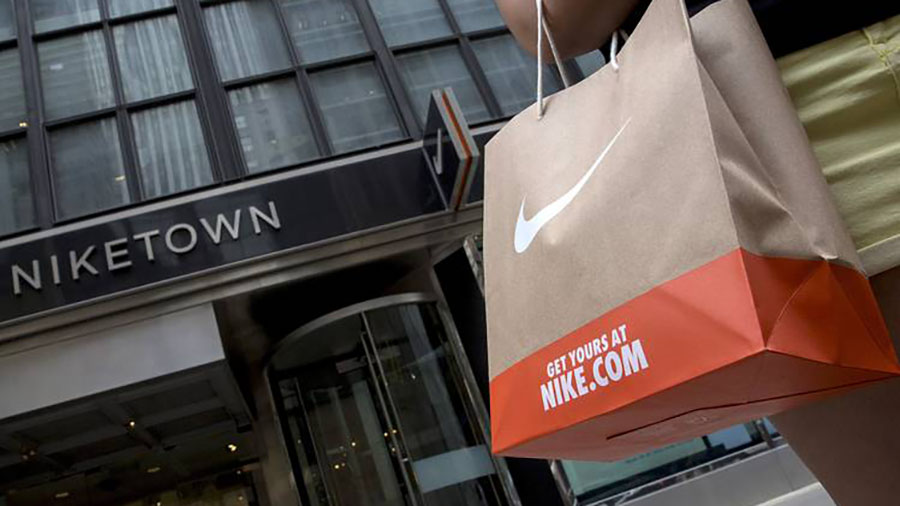Nike’s shares rose 6.7 percent on Friday after the company reported earnings in the fiscal first quarter ended August 31 handily topped expectations on stronger-than-expected margins, but many analysts were non-plussed, remaining concerned about sluggish growth trends, particularly in the North American wholesale channel.
Shares closed Friday at $95.62, up $5.99 on the day. On Monday, shares closed at $94.54, down $1.08. The stock’s 52-week range is between $82.22 and $131.31.
Highlights of the first quarter included:
- Sales rose 2.0 percent to $12.94 billion, just short of analysts’ consensus target of $12.99 billion. Nike had predicted revenue growth to be flat to up low single digits, reflecting its efforts to tighten first-half buys and restrain marketplace inventory.
- Revenues for the Nike Brand were $12.4 billion, up 3 percent on a reported and currency-neutral basis, led by currency-neutral growth in EMEA, Greater China and APLA, partially offset by a decline in North America.
- Revenues for Converse were $588 million, down 9 percent on a reported and currency-neutral basis, due to a decline in North America, partially offset by growth in Asia.
- Nike Direct revenues were $5.4 billion, up 6 percent compared to the prior year on a reported and currency-neutral basis with growth across all geographies. NIKE Brand Digital sales increased 2 percent on a reported and currency-neutral basis.
- Wholesale revenues were $7.0 billion, flat compared to the prior year on a reported basis and up 1 percent on a currency-neutral basis.
- Earnings slid 1.2 percent to $1.45 billion, or 94 cents a share, from $1.47 billion, or 93 cents, a year ago, but came in well ahead of analysts’ consensus estimate of 74 cents.
- Operating earnings declined 9.8 percent to $1.65 billion from $1.83 billion a year ago with the operating margin eroding to 12.7 percent from 14.4 percent a year ago.
- Gross margins decreased ten basis points to 44.2 percent, exceeding the consensus target of 43.7 percent. Higher product costs and unfavorable changes in net foreign currency exchange rates offset strategic pricing actions. Nike has projected gross margins would be down 50 to 75 basis points.
- Nike inventory dollars were down 10 percent at the quarter’s end versus the prior year.
- Nike reiterated its outlook for the fiscal year ended May 31, 2024, continuing to expect reported revenue to grow mid-single-digits. Gross margins are still expected to expand 140 to 160 basis points on a reported basis.
- Second-quarter sales are expected to be up slightly as the quarter laps Nike’s “most challenging comparisons” in FY23. Gross margins are forecasted to expand by approximately 100 basis points, reflecting benefits from strategic pricing, improved markdowns and lower ocean freight rates.
BMO Capital maintained its “Outperform” rating while lowering its price target to $110 from $120.
BMO analyst Simeon Siegel wrote, “Based on our conversations, we believe investors grew heavily concerned around China and North America, leading many to expect a guidance cut. Although this was another quarter with declining EBIT, we believe sentiment had grown too negative and management continues to stress confidence in the future (echoing prior views while commending retail partners) which we expect to drive a relief recovery in shares.”
Siegel said he continues to see signals that Nike is rebalancing its DTC push. The analyst noted that on Nike’s fiscal fourth quarter call, Mark Friend, CFO, noted that “the consumer will decide the ultimate endpoint,” implying Nike’s goal of reaching 60 percent DTC penetration may be adjusted. On the first quarter call, management again “spoke encouragingly about its wholesale partners,” Siegel pointed out, in another sign of its recommitment to wholesale. He also noted that first-quarter results signaled that DTC margins were under pressure.
Raymond James reiterated its “Outperform” rating at a price target of $121.
Rick Patel said that while Nike contends marketplace inventories for its products are aligned with demand, “we still worry about elevated activewear inventory in the market broadly, based on our checks, which could weigh on sell-in.”
On the positive side, Patel said Nike’s guidance for second-quarter sales was better than feared. Nike officials indicated retail sales across Nike Direct and wholesale were up mid-single digits in the fiscal first quarter and similar gains are seen for the fiscal second quarter.
Nonetheless, Patel said first-quarter results reinforced his expectation that Nike’s FY24 performance will continue to be marked by strong margin expansion due in part to easing supply chain constraints and improved efficiencies while sales lag due in part to challenges lapping strong wholesale gains in the prior year. Patel stated, “The F1Q beat was not demand-driven, and it’s unclear how much wiggle room guidance has for student loan headwinds or slower China growth…so we don’t see it as a narrative changer that NKE is under pressure.”
BOFA Securities reiterated its “Neutral” rating at a $110 price target.
Lorraine Hutchinson wrote, “While we are bullish on the long-term prospects for Nike’s accelerated innovation and digital strategy, we see risks from a difficult North American retail environment and margin weakness in China that balance the risk/reward.”
She noted that Nike’s management was encouraged by the mid-single-digit retail sales growth, including high-single to low-double-digit gains at key global wholesale accounts. Hutchinson wrote, “The company spoke of a strong innovation pipeline and a focus on driving improved consumer connectivity with its running franchise. We think these two factors are crucial to drive growth going forward.”
On the downside, she noted that while China continued its recovery, margins in the region came in lower than her team expected. Hutchinson wrote, “China margins are over 600bp below peak levels, making outsized sales growth in the region important for the longer-term margin story.”
TD Cowen reiterated its “Outperform” rating while slightly raising its price target to $120 from $117.
John Kernan wrote that market sentiment had been “overly negative” heading into the quarter. He said his team has become “incrementally more constructive” after first-quarter results but noted that Nike EBIT margins will have to expand between 250 and 300 basis points in the second half of its fiscal year to reach FY24 guidance. He added, ‘Pricing taking will continue to be a margin tailwind, and H2 will get the benefit from lower freight that is expected to partially benefit Q2.”
Kernan highlighted that Nike’s reaffirmation of guidance shows confidence that FY24 is a turning point toward its long-term margin targets. The analyst observed, “Q1 could be the initial proof point that Nike’s margin structure has bottomed and higher ASPs (average selling prices), recent investments, and lower supply chain costs will set a framework for more profitable growth in FY24 and FY25.”
Barclays kept its “Overweight” rating while narrowing its price target to $119 from $124.
Adrienne Yih described Nike’s performance as “a mixed bag with something for both the bulls and the bears to chew on.” She noted that sales came in below expectations due to shortfalls in China and Converse. On the positive side, gross margins and SG&A expenses both topped expectations, and inventory levels impressed.
Addressing investor concerns, Yih said she continues to expect Nike’s wholesale challenges to persist. She wrote, “We reiterate that the wholesale destocking is simply the bullwhip effect of excess inventory and aggressive sell-in to wholesale partners last year. We believe we could see the end of the cycle by mid-calendar 2024.”
In China, she noted that while sales growth of 12 percent on a currency-neutral basis missed Bloomberg consensus expectations of 17.6 percent, the region saw an acceleration in full-price selling, strong traffic, increased purchase frequency and market share gains. Yih wrote, “It remains to be seen how the macro backdrop will impact the rest of the year, but we are forecasting HSD organic growth in the region.”
In North America, she noted that DTC growth is slowing, as expected, with year-ago results boosted by liquidation activity, particularly in apparel.
Yih believes the stock will face challenges until “greater clarity” arrives on the wholesale recovery and overall macroeconomic climate. Yih wrote, “NKE remains the dominant footwear brand, both in North America and globally, inventory is now right-sized with sales growing faster than inventory, and wholesale destocking should be completed by the end of the year.”
Baird maintained its “Outperform” rating at a $125 price target.
Jonathan Komp said he was encouraged by Nike’s first-quarter results, particularly the “healthy inflection” in gross margin and its “solid pipeline of product/initiatives” that gave Nike confidence to maintain its FY24 guidance despite lingering U.S./China economic uncertainties. Komp said, “In our view, NKE’s update signals less near-term earnings downside risk and thus warrants some multiple re-expansion, though patience may still be needed since back-weighted 2H plans could remain somewhat of an overhang.”
Stifel kept its “Buy” rating at a price target of $135.
Jim Duffy wrote that investor sentiment “had swung too negative,” particularly around the brand’s performance in North America. He said share gains are likely to be limited in the near-term given macro concerns and Nike’s guidance being weighted to the second half of its year. However, Duffy remains confident in Stifel’s “Buy” thesis. Duffy stated, “We continue to view FY24 as the first of multiple years where NKE margin structure normalizes higher. Secular tailwinds for the category and structural margin opportunities support the case for strong underlying earnings power in future years.”
Williams Trading upgraded Nike’s shares from “Sell” to “Hold” and slightly increased its price target from $91 to $92.
Sam Poser wrote, “The main reason for our upgrade is the increasing efficiency of expense spending, and the associated improving supply chain efficiency. At the same time, we continue to believe that the implied 2H24 revenue guidance is too optimistic.”
He said retailers his team has spoken to “are far less enthused” about Nike’s 2024 product than Nike’s management team. Poser said, “While there is some good new Retro Jordan product, most categories, including running, which is in dire need of some new exciting product, have received an underwhelming response.”
Poser also said he remains concerned that Nike is pushing too much product into the moderate channel in the U.S., “and full price sales of premium product in the U.S., and perhaps beyond, will be negatively impacted by selling below MSRP on resale websites such as StockX.”
From a profitability standpoint, Poser said the path to its goal of high-teens EBIT margin appears uncertain. He said, “It still appears to us that NKE is putting revenue growth ahead of brand equity, but to what degree is unclear.”
Bernstein maintained its “Outperform” rating and price target of $134.
Bernstein analyst Aneesha Sherman wrote in a note, “Nike posted a nice Q1 beat and maintained FY24 guide, using the about 20c EPS beat to de-risk Q2 and cushion H2 – the best possible outcome we could have expected from this print. The combination of decelerating macro and debates on DTC and Running will keep an overhang over the stock ST – but we remain bullish on the stock LT as an undervalued outperformer, with EPS growth forecasts outperforming peers and valuation at a 5-yr low.”
Deutsche Bank kept its “Buy” rating at a price target of $99.
Analyst Gabriella Carbone wrote, “Overall, we are pleased with results and believe marketplace commentary bodes well for the athletic space, which has been under pressure due to excess inventory. While NKE still has work ahead of them to improve profitability, we think 1Q results signal that the company is on the right track.”
UBS reiterated its “Buy” rating at a price target of $155.
Jay Sole said, “Nike’s long-term outlook is attractive, in our view. We continue to think Nike’s investments in product innovation, supply chain speed, and digital will unlock a multiyear period of above average growth. Plus, we believe Nike has the brand strength, strategy, skills, resources, and balance sheet to outperform peers through a recession. Nike’s 1Q24 earnings report gives us increased conviction in this view. We think the market is underestimating many aspects of Nike’s growth outlook, but the main one is Nike’s EBIT margin rebound potential.”
Photo courtesy Reuters
















